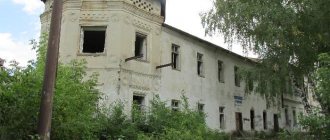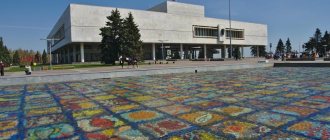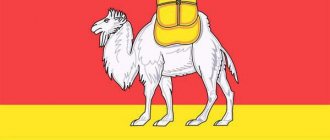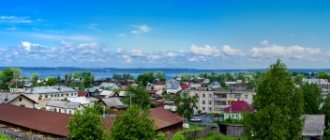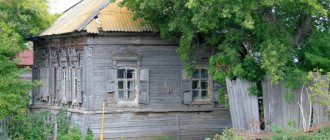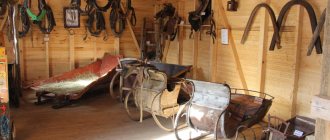The most interesting places in Dimitrovgrad – TOP-3
Once in Dimitrovgrad, the first thing you should pay attention to is its “tricks” - special places that reveal the essence of the life and culture of the city.
Museum of Local Lore
- Address: Proninoy street, 21.
The Dimitrovgrad Local History Museum was opened in 1964. It is based on a collection compiled in 1920-1950. local historian Stepan Dyrchenkov.
At the end of the 1970s, the museum moved to one of the most beautiful buildings in the city, which was built by the merchant Konstantin Markov at the beginning of the 20th century. The two-story brick house with a kokoshnik roof resembles a fairy-tale tower. On the sides of the main mass there are wings with arched entrances.
Museum exhibitions occupy several halls, each of which is dedicated to a specific topic:
1 The exhibition “Nature of the Native Land” focuses on the living world of the Ulyanovsk region. On both sides of the long corridor there are glass display cases in which the forest landscape is recreated, complemented by stuffed animals and tree models. A separate part of the exhibition is dedicated to prehistoric creatures that inhabited the abyss of water during the Mesozoic and Paleozoic eras. Behind the glass are the fossilized remains of ammonites, trilobites and other arthropods discovered by paleontologists.
2 In the halls with a recreated atmosphere of noble and peasant life there is an exhibition telling about the life of Melekess at the turn of the 19th-20th centuries. The exhibits include authentic household items, antique furniture, textile elements and tools.
3 The museum's largest collection is "Relics of the Second World War." Here you can see weapons of that time, soldiers' uniforms, helmets found during excavations, shell fragments, personal belongings of soldiers: flasks, cigarette cases, watches. The handwritten letters deserve special attention, many of them containing suicide notes.
4 In the “Master Cluster” section, excursionists will learn everything about nuclear energy and medical radiology.
5 The exhibition “Living Earth” is perfect for children. In it, a collection of minerals and minerals is presented through the prism of the fairy tale “The Stone Flower” by Pavel Bazhov.
The museum program often includes lectures, master classes, as well as meetings with local historians and local historians.
Drama Theater named after A.N. Ostrovsky
- Address: st. 3rd International, 74.
The Dimitrovgrad Theater was founded in 1908. Initially, it was a small auditorium rented by enthusiastic directors for amateur productions. Gradually the institution developed to the status of a professional theater. Over the years of its existence, almost all of Alexander Ostrovsky’s works have been staged there. In addition, plays by Russian and foreign classics, including Shakespeare and Schiller, were staged.
Today the theater’s repertoire includes productions based on famous literary works: “Anna Karenina” by L.N. Tolstoy, “One Flew Over the Cuckoo’s Nest” by Ken Kesey, “Crime and Punishment” by F.M. Dostoevsky, etc. The children's program is based on fairy tales by Andersen, Pushkin, and Perrault.
The Drama Theater is located in a recognizable building built at the beginning of the 20th century. The dark facade contrasts sharply with the snow-white architraves, turrets, jagged cornices and figured columns that make up the veranda fence. In front of the building there is a small area with decorative flower beds.
Stele "Three Pines"
- Coordinates on the map: 54.212832, 49.541351.
Since ancient times, three pines have been a symbol of Dimitrovgrad. These majestic trees symbolize the beauty and richness of their native land, as well as the strong connection between the city and nature. Three pines are depicted on the coat of arms and flag of Dimitrovgrad, and in 2002 they appeared at the entrance to the city in the form of a metal stele. The monument schematically depicts a group of three trees growing so close that their branches are intertwined.
State Scientific Center Research Institute of Nuclear Reactors
- Since 1964, the institute has operated correspondence postgraduate courses in five main areas of R&D
- Part of the State Atomic Energy Corporation Rosatom
- The company was founded on March 15, 1956
The city-forming enterprise is a valuable attraction of the former Melekess. There are 6 nuclear reactors operating here, as well as a radiochemical complex. The organization was created in the mid-20th century. The research institute has the largest complex for the study of nuclear reactor zones among all European countries. Excursions are conducted to the territory of the institute, during which you are not allowed to use the phone or take pictures of objects.
Dimitrovgrad cultural institutions
Great attention is paid to cultural life in Dimitrovgrad. In centers that focus on science and art, you can not only have a good time, but also learn a lot of new and interesting things.
Scientific and Cultural Center named after E.P. Slavsky
- Address: Dimitrov Avenue, 12.
The Dimitrograd Scientific and Cultural Center is deservedly recognized as the best in the Ulyanovsk region. Being under the auspices of the Nuclear Reactor Research Center, it organizes large-scale scientific exhibitions, cultural events and promotes the advantages of nuclear energy.
The complex is located in a huge Soviet-built building. It houses the city's largest concert hall, as well as exhibition spaces, lecture rooms, meeting rooms and the Hermitage Hall, where exhibitions of local artists are held.
In addition, the NCC operates children’s clubs and sections: “English Club”, the “New Style” dance school and the “Rainbow” pop song studio. Students of these clubs perform concerts at festive events organized by the complex, which gives the attractions a local flavor.
Workshop-gallery of picturesque relief by Olga Yudinskikh
- Address: Lenin Avenue, 2.
Olga Yudinskikh is an artist reviving the traditions of icon painting of the 16th century. Her workshop is a real museum, displaying carved icons created in modern times, but with the appearance of ancient works of art.
The collection of picturesque reliefs contains not only examples of icon painting, but also paintings with natural landscapes, portraits and illustrations of fairy tales. There are no analogues to the work of Olga Yudinskikh throughout the country. Her creations are exhibited in museums in Russia and abroad.
Nikas Safronov's open-air vernissage
- Address: Lermontov street, 8a.
Dimitrovgrad boasts the world's only open-air vernissage of Nikas Safronov. The gallery, called “The Brilliant Province of Russia,” presents giant reproductions of the artist’s paintings on the walls of two-story buildings. The number of paintings reaches thirty-three. Most of it is made in the style of symbolism, to which the artist gives the greatest preference.
Dimitrovgrad on the map of Russia, geography, nature and climate
If you look at a satellite map of Dimitrovgrad, you can see vast forests among which the city is located. These include mixed forests and pine forests. During construction, residential areas are successfully integrated into the “green” zone.
Dimitrovgrad is located in the Volga region, where low-lying terrain prevails (with an altitude of 50 to 100 m).
The city is located in a temperate continental climate zone, the seasons of the year are clearly defined:
- The average temperature of the coldest month of winter, January, is 13°, frosty weather lasts until mid-March.
- Real warmth comes from the second ten days of May.
- Average temperatures in July are from 20 to 22°.
- About 300 mm of precipitation falls annually.
What to see in Dimitrovgrad from architecture
Many buildings in Dimitrovgrad were built in pre-revolutionary times and rise in quiet corners of the modern city, like majestic ghosts of the past. Such structures help to imagine what Dimitrovgrad looked like in those days when it was called Melekess.
Bechina Estate
- Address: st. 3rd International, 70.
This brick estate in the eclectic style was erected in the mid-19th century by a small merchant Fyodor Bechin. The two-hundred-year-old building has become very dilapidated, but its facade has perfectly preserved decorative elements, which the architect clearly did not skimp on.
The plastered walls of the attraction are decorated with ornaments, niches with bas-reliefs in the shape of chess pieces, pilasters and fringed lambrequins carved from stone.
During the times of prosperity, a luxurious garden was laid out around the estate, but now not a trace remains of it. The Bechina estate is recognized as the architectural heritage of the city and is protected by our state.
Zhirnov Trading House
- Address: Gagarina street, 19.
The two-story building in the classicist style was erected in the 19th century and belonged to the Zhirnov merchant family, which supported itself by selling sugar, textiles, and wine and gastronomic goods.
It is also famous for the fact that it housed the city's first telephone exchange. During Soviet times, the house was converted into a school, and during the war years it housed a hospital. Today there is a branch of the Samara Humanitarian Academy operating here.
Apartment building "Bulgar"
- Address: st. 3rd International, 95.
The apartment building was erected at the turn of the 19th and 20th centuries according to the design of the architect A. Voloshina. The composition of the two-story building is distinguished by restraint and elegance. The stone walls are painted beige, with whitewashed decorative masonry standing out against their background. In pre-revolutionary times, the house was intended for the People's Assembly, and after 1917, the bodies of Soviet power were located in it. Today there is a bank in the building.
Crime
Even in the crime-ridden 90s, the city cannot remember a single major shootout. Although there were shots, they were somehow not mentioned in the central news. Major crime moved towards Moscow, where it was successfully legalized. Those who remained are most likely waging some kind of struggle among themselves (where would we be without this), but they don’t particularly bother the townspeople. The problems of the criminal police are caused only by individual elements, without an organizational component.
The events of 1974, which were breathlessly broadcast by Voice of America and Svoboda, left a noticeable mark on the history of the city. The whole story began on a dance floor in a city park, where local youth came into conflict with military personnel. The fight went beyond the limits of everyday life, as a result of which 2 police UAZ cars were overturned, and someone allegedly heard shooting, which, most likely, did happen. But attempts to give these events a political overtone were unsuccessful. All they did was remove the official responsible for working with young people, and the direct participants in the events, by today’s standards, escaped with a slight fright.
In recent years, the situation in the city has been quite calm, although everything should be understood in comparison.
Dimitrovgrad Orthodox temples and churches
Orthodox cathedrals and churches of Dimitrovgrad stand out against the background of ordinary city buildings. All the powers of talent and creative thought with which the architect approaches the performance of his work are invested in these buildings.
Spaso-Preobrazhensky Church
- Address: Kuibysheva street, 215.
The Transfiguration Church stands on the site where the Cathedral of St. Nicholas the Wonderworker, also known as the “White Church,” stood in the 19th century. The historic building was destroyed in the 1930s. and for a long time his land was empty. Only in the early 2000s a new temple was built on this site.
The brick church with a hipped bell tower was popularly nicknamed “Red”. It is crowned with two gilded domes: a large one (on the drum of the central attic) and a small one (on the roof of the eastern wing). Now the Transfiguration Church receives parishioners every day, organizes holidays and teaches children in Sunday school.
St. Nicholas Cathedral
- Address: Chapaeva street, 14.
The predecessor of the modern temple was an old wooden church that burned to the ground in the 1970s. The new temple was built in 1988 and its opening was timed to coincide with the celebration of the 1000th anniversary of the baptism of Rus'.
The white stone temple seems airy and weightless. It rises above the ground like a cloud castle topped with sky-blue domes. Next to it rises a belfry, filling the air with the iridescent singing of bells.
The territory of the cathedral is fenced with a forged fence. The main entrance is marked by arched gates, on the supports and top of which there are slabs with images of icons.
Church of the Great Martyr George the Victorious
- Address: Mullovskoe highway, 40.
The small temple was built on the initiative of Konstantin Dolinin, a young man, yesterday’s student, who had absolutely no funds. He organized a fundraiser, but there was always not enough money, which is why the construction of the church was constantly suspended. Failures did not stop the young man; he patiently and stubbornly moved towards his goal and eventually achieved it.
By the winter of 2002, the temple was completely completed and consecrated in the name of St. George the Victorious. Small, it is endowed with an unusual style. It is covered with cascading roofs finished with blue tiles. In the center of the main building and the low bell tower are drums topped with silver domes. The temple stands in the middle of a field surrounded by pine forest. This is a rare case when nature and civilization, intersecting, perfectly complement each other.
Coat of arms
The coat of arms of Dimitrovgrad is presented in the form of a French shield. Three golden pines are depicted on a blue background. They rise above a black area symbolizing the earth.
Trees embody the riches of nature, the connection with the environment, and distillery production, which influenced the formation of the settlement. Crowns indicate the source of active life, the desire for perfection and knowledge. Precious metal reflects wealth, strength, strength, intelligence.
The coat of arms was adopted by the Decision of the Council of Deputies of the city of Dimitrovgrad No. 28/333 of July 31, 2002. Included in the State Heraldic Register of the Russian Federation under No. 1014.
Which memorials in Dimitrovgrad are worth visiting?
A city that has lived for centuries certainly has something to remember – these memories of the past are captured in stone and bronze memorial sculptures.
Monument of Eternal Glory "Motherland"
- Address: Walk of Fame.
The monument is dedicated to fellow countrymen who did not return from the battlefields of the Great Patriotic War. It is a bronze sculpture of a woman whose face is sad and at the same time full of pride.
Her lowered clenched fist betrays her mental anguish. With her right hand she raises an oak branch above her head - a symbol of courage and perseverance. The sculpture stands on top of an 11-meter stele made of red granite. At its foot are two capsules: one contains hidden letters addressed to fallen soldiers, and the other contains soil collected from the places where the fiercest battles took place.
The opening of the monument took place in 1975 - on the day of celebration of the 30th anniversary of the Great Victory. At the same time, the square where rallies are held today was built, and the Eternal Flame was installed.
Fraternal Cemetery
- Address: corner of Kuibyshev and Pronina streets.
In the center of the city there is a memorial complex known as the “Brotherly Cemetery”. Three people found eternal peace in this place:
- Hero of the Soviet Union Arkady Baryshev, who served in the airborne units during the Second World War.
- Maria Pronina - teacher and delegate of the VIII Extraordinary Congress of Soviets, killed by robbers in 1936.
- N.P. Zheltov - chairman of the executive committee in wartime.
Sculptor V. Shchelonov made busts of Baryshev and Pronina, as well as a large-scale statue called “Trumpeter of the Revolution.” The monuments were erected at the burial site in November 1981.
Monument to Georgiy Dimitrov
- Address: Alley of Teachers.
Georgiy Mikhailovich Dimitrov was a prominent international figure, a Bulgarian revolutionary, and a participant in the communist and anti-fascist movement. In 1972, Melekess was renamed Dimitrovgrad in memory of this man, and ten years later a monument dedicated to him appeared in the city.
The bronze figure of Dimitrov was created by sculptor L. Baltoyan. He depicted the revolutionary in full growth with his hands behind his back. The statue is mounted on a high pedestal made of red granite. Its front part is decorated with a slab with a bas-relief by Georgiy Dimitrov.
Monument to merchant K.G. Markov
- Address: corner of 3rd International and Samarskaya streets.
Merchant Konstantin Grigorievich Markov made a huge contribution to the development of Dimitrovgrad. Being the head of the townsman, he erected residential buildings, trading shops, wooden buildings for farm plots and stone buildings for city institutions. Under Markov, the city's population increased significantly, economic and production activities strengthened.
In 1919, Konstantin was arrested for taking part in a protest against the dispersal of the Duma during the Revolution. They say that some townspeople who had respect for the merchant dared to run after the cart on which he was being taken away and throw bundles of food and clothing into it.
Markov's further fate is unknown. There is a version that he was shot in Samara, but there is no documentary evidence of this. The monument to the benefactor was erected in September 2003. The sculptor S. Mokrousov depicted Konstantin in a merchant’s attire, holding an elegant cane in his hands. The bronze sculpture is placed on a high granite pedestal with a memorial slab.
Monument to the first mill
- Address: Proninoy street, 4.
In the 18th century, bakery production in Dimitrovgrad reached its prosperity. Eight mills were built on the banks of the Melekesski River. Today, on this site there is a copy of the mill, built according to drawings two hundred years ago. It is a miniature house made of logs.
At the foot you can see a wheel that was driven by the flow of water. This mill is not a working one and serves only a memorial role. It is installed on a stone pedestal with a metal tablet, which outlines a brief history of the Dimitrovgrad mill business.
Where to go for a walk in Dimitrovgrad
In good weather, it's nice to spend time outdoors. In Dimitrovgrad there are a couple of places for such a holiday.
Markov Garden
- GPS coordinates: 54.218452, 49.629081.
The garden, dedicated to the memory of the merchant Markov, has everything you need for long walks in nature. The paths stretch through deciduous groves; along the way you can often see wooden statues depicting fairy-tale characters and forest inhabitants. The green area, where there are no lawns or smooth alleys, but only the riot of nature, is replaced by landscaped areas with fountains and bright flower beds. The garden is perfect for hiking, cycling and skiing. There are benches throughout the area where you can relax and then continue your walk.
Lover's Bridge
- Coordinates: 54.223543, 49.615516.
In the early 2000s, a forged bridge was thrown across Markov Pond, called the “Bridge of Lovers.” He added the finishing touch to the landscape of the reservoir, turning it into one of the most beautiful places in the city.
From the bridge there is a magnificent view of the pond and the banks buried in a birch grove. Jets of fountains burst out of the water. It is not surprising that this picturesque corner has become a venue for wedding photo shoots.
Following a long-standing tradition, the newlyweds attach locks to the bridge cage, symbolizing the strength of their love, and send the keys to the bottom of the pond. We can say that the Bridge of Lovers is a repository of romantic stories of Dimitrovgrad couples.
Square of Current Literature
- Coordinates: 54.207907, 49.616427.
The square is famous for its original design. His decorations are letters, books and characters from Russian fairy tales, made from various materials: from stone to grass. It is especially useful for children to visit here, because the purpose of the park is to instill in the younger generation a love of reading. While walking, you can teach preschoolers letters. Learning in a playful way will be interesting and useful for the child.
See also the sights of Ulyanovsk
Exciting holidays await those whose road turns towards Dimitrovgrad. When going here, don’t forget to take a camera, because there are no such amazing places as in this city in any corner of our vast country.
Infrastructure development
Dimitrovgrad is advantageously located in terms of transport: you can access any highway in the Volga region, as well as the federal highway. By road you can get to Moscow, Kazan, Samara, Ulyanovsk, Cheboksary, Orenburg, Saransk. There are good railway connections with all regions of Russia. Shuttle buses and taxis connect areas of the city; from the bus station you can go to nearby towns and villages.
The main enterprise of the city is the Research Institute of Nuclear Reactors, whose scientific achievements are known not only in Russia, but also abroad. Another large enterprise is the aggregate plant (DAAZ), where equipment for cars is produced. For more than 80 years, the Khimmash plant has been producing equipment for the oil and gas industry. Urban construction is supervised. Apartment buildings and cottages are being built, and applications for private construction are being accepted. Residential buildings and institutions are serviced by housing and communal services enterprises.
Trade and commercial services are well developed in Dimitrovgrad. Here are the chains of hypermarkets "Lenta", supermarkets "Fix Price", "Pyaterochka", "Magnit", as well as small shops. A very convenient site for joint purchases “Ulpurkupki” in the Ulyanovsk region, where more than a million products are presented. As for the healthcare sector, in 2022 the Dimitrovgrad Center for Nuclear Technology Medicine, one of the largest in Europe, was put into operation.
The television available in Dimitrovgrad broadcasts the TNT and REN TV channels, as well as transmits local news and advertising, and creates city projects. At the expense of the Ulyanovsk State Television and Radio Broadcasting Company, residents of the city and region watch the Rossiya TV channel. There are 62 cable television channels and digital broadcasting. News about the city can be seen not only on the official website, but also on VKontakte.
